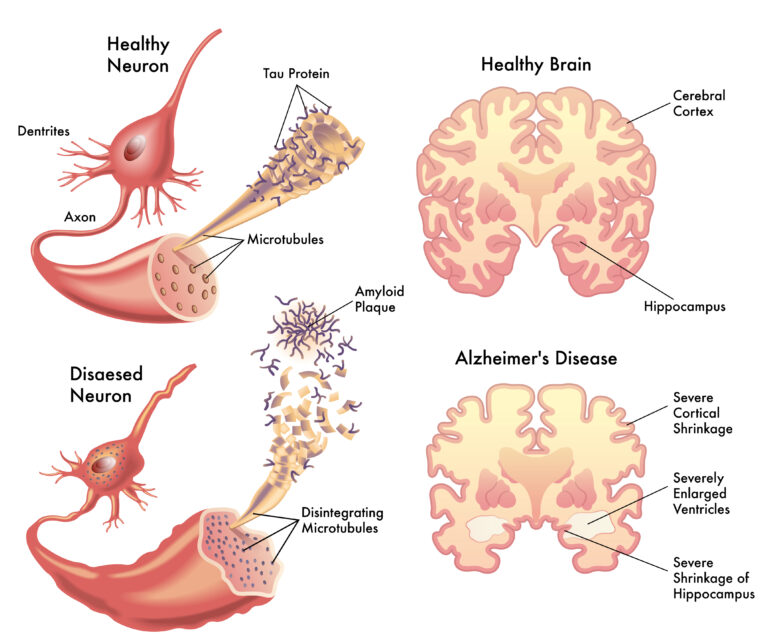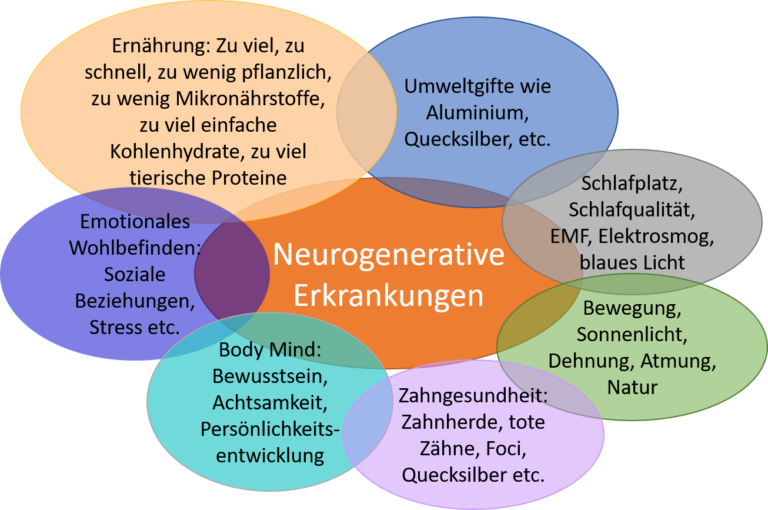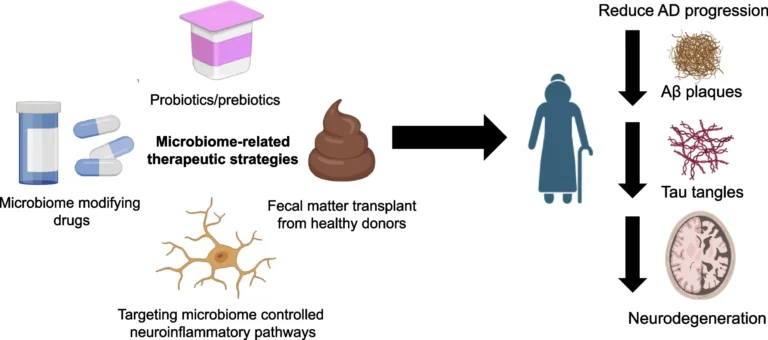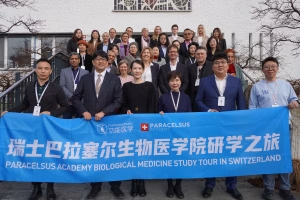There is evidence that inflammation in the brain plays a role in various neurodegenerative diseases. This newsletter aims to explain to you what neurodegenerative diseases are, how they develop, which risk factors need to be taken into account and what you can do yourself or how we can help you with the help of biological medicine at the Paracelsus Clinic.
What are neurodegenerative diseases (NE)?
The brain consists of a large number of nerve cells that are connected to each other. These connections are known as synapses, and there are receptor sites on them, known as receptors, through which messenger substances are sent over very short distances.
In the case of Parkinson’s, for example, it is the receptors for dopamine, which are located in a specific area of the substantia nigra (black matter) and are destroyed due to deposits of incorrectly folded proteins (alpha-synuclein=Lewy bodies), without this process being fully understood. In addition to this specific process, many other things happen in the body before the onset of the disease, which we refer to as multi-system disease. These include disorders of smell, sensation, the psyche, the vegetative system, sleep, the gastrointestinal tract, etc. For example, chronic constipation often precedes the onset of Parkinson’s by up to decades (1).
The same is true of Alzheimer’s dementia, in which so-called tau proteins in particular detach the nerves and lead to the destruction of large areas of the brain (see Figure 1). Only a few cases are genetic, but there are genetic risk factors, such as apolipoprotein E in Alzheimer’s, which is thought to protect the nerves from harmful substances.

Fig. 1: In Alzheimers, tau proteins are deposited on the nerves and destroy neurons. rob3000 – stock.adobe.com
Therapy options in conventional medicine
For neurodegenerative diseases such as Parkinson’s and Alzheimer’s, there is currently no therapy that can significantly influence the course of the disease. In the case of Parkinson’s disease, there are drugs such as L-dopa and amantadine that can significantly improve symptoms such as stiffness (rigor), tremor and slowed movements (bradykinesia) in the early, mild stages. Unfortunately, these drugs are associated with long-term side effects, which lead to reluctance to use them, especially in younger patients.
For Alzheimer’s, even symptomatic improvement through medication is only minimal. A new drug for Alzheimer’s, lecanemab, is currently being approved, which is designed to reduce the tau proteins. However, it must be administered at a very early stage in order to have a slight positive effect on the course of the disease over several years. Despite its limited success and significant side effects, such as frequent brain swelling, health insurance companies and patients are provided with more than CHF 25,000 per year in therapy costs for life.
Prevention and intervention for NE
Fortunately, the situation is much better when it comes to prevention. As the first symptoms of neurodegenerative diseases can appear decades in advance, there are enough early warning signs to take preventive measures at an early stage. According to official figures, 40% of dementia cases can be avoided with the following extremely effective measures, see Fig. 2 (2). We are convinced that in-depth knowledge of the causes can significantly increase this percentage. Even in the advanced early stages of the disease, therapies and preventive measures are still highly effective, whereas they tend to lose their effectiveness in more severe cases.

Fig. 2: Prevention, intervention and care of dementia
Livingston, Gill, et al. “Dementia prevention, intervention, and care: 2020 report of the Lancet Commission.” The Lancet 396.10248 (2020): 413-446.
Research into causes
At our clinic, we have been working intensively on research into neurodegenerative diseases and have discovered further key causes that can have a significant influence on the course of these diseases. This individual causal research for each patient is of great importance as it helps us to develop better approaches for treatment. Identifying these factors helps to improve the quality of life and the prognosis for a positive course of the disease for those affected. Identifying the causes is an important step towards a better understanding of these diseases and gives us hope for more effective therapies and preventive measures.
The most important factors that we consider and research individually for each patient with NE such as Parkinson’s or dementia are as follows:
– Environmental toxins, especially neurotoxins
– Electromagnetic fields (EMF), especially in the sleeping area
– Nutrition
– Movement and breathing
– Body Mind Topics
– Dental health

Fig. 3: Biologically and medically recognized causes of neurodegenerative diseases
Therapeutic approach for neurodegenerative diseases in biological medicine
Pillar 1: Detoxification
After careful diagnosis and research into the causes, we usually recognize toxic exposure to heavy metals or environmental toxins such as bisphenols etc. The Paracelsus Clinic specializes in detoxifying the body with various therapeutic measures.
For example, we can specifically detoxify heavy metals with chelate infusions.
Plasma apheresis for NE
Since this year, the Paracelsus Clinic has also been offering plasma apheresis. The aim of plasma apheresis (see Newsletter August 2023 for what this is). The aim of plasma apheresis is to remove disease-causing substances such as inflammatory substances that cause neuroinflammation and to preserve the positive components. Although randomized controlled trials are still pending, this procedure is already being used for neurodegenerative diseases and positive effects have been observed in individual case reports. However, it should be noted that the therapy probably needs to be carried out on a regular basis.
Holistic dentistry
Paracelsus dentistry is particularly important to us for optimal detoxification. Our long-standing collaboration with the Paracelsus Dental Clinic has proven to be extremely important for our patients. Patients with neurodegenerative diseases are advised by means of a dental tomogram and toxicological examinations to determine whether there may be a dental health-related cause for the disease. It is striking how frequently dental and heavy metal exposure can accompany neurodegenerative diseases and how the course of the disease can be positively influenced immediately after appropriate remediation. (See video testimonial: https://youtu.be/naJN99plS5Y).
Our observations are supported by numerous scientific studies showing that heavy metals such as mercury from amalgam fillings can play a significant role in neurodegenerative diseases such as Alzheimer’s (3-6). However, the removal of amalgam should be carried out with maximum precautions and extreme caution. This approach has been successfully practiced at the Paracelsus Clinic for many years through very close collaboration with dentists and has proven successful in many medical cases. Therefore, we cannot emphasize enough how important it is to include dental health, especially when chronic diseases are involved.
Pillar 2: Microbiome and gut-brain axis
The microbiome, the community of bacteria and other microorganisms in the digestive tract, not only influences digestion, but also the immune system and inflammatory reactions in the body. For years, the microbiome (intestinal bacteria) has increasingly become the focus of conventional medicine, something that the Paracelsus Clinic has been observing, investigating and successfully treating for many years.
This connection is described as the gut-brain axis and comprises various mechanisms (see Fig. 4):
- On the one hand, substances such as short-chain fatty acids or even neurotransmitters such as dopamine are produced by the microbiome predominant in the intestine and these are passed on to the brain via the blood and lymph.
- In addition, some substances such as biofilm proteins or the deposits typical of Parkinson’s disease (Lewy bodies) are transported directly to the brain via the vagus nerve.
- Various substances that pass through the intestinal wall (particularly pronounced in the case of “leaky gut”) release inflammatory substances into the blood, which cause inflammation of the nerves and this in turn leads to increased deposition of harmful substances such as tau proteins. These substances also cause the blood-brain barrier that protects the brain to become perforated, creating a type of “leaky brain” (7,8).
From "leaky gut" to "leaky brain"
One of the main causes of neuroinflammation and diseases such as dementia, Alzheimer’s, autism, MS and depression is therefore found in the gut, according to an increasing number of studies (8). The Paracelsus Clinic has many decades of experience in intestinal reconstruction. First of all, we arrange a detailed stool test. Based on the detailed microbiome diagnostics, we can individualize the therapy plan for intestinal reconstruction and give probiotics (good intestinal bacteria) and prebiotics (special dietary fibres that promote the good intestinal bacteria) that are as targeted as possible. In neurological diseases in particular, the intestinal mucosa is often inflamed and, as described above, “leaky gut syndrome” is associated with the “leaky brain”.
Therefore, our therapeutic approach, similar to the study mentioned in Fig. 5 (9), our therapeutic approach includes four important components:
- Pre- and probiotics to build up the intestinal flora.
- Diet and supplements that can modify the microbiome to create the right breeding ground for the good bacteria.
- Colon hydrotherapy with reflorization.
- Restoration of the intestinal mucosa to reduce intestinal neuroinflammation.
In addition, if necessary, special methods such as the intensive Paracelsus intestinal biofilm cure or the liver detoxification program are used so that intestinal health can be rebuilt from the ground up. This enables us to achieve better results in the long term.

Fig. 4: Microbiome structure in Alzheimers reduces neurodegeneration.
Chandra S. et al. The gut microbiome in Alzheimer’s disease: what we know and what remains to be explored. Mol Neurodegeneration 2023: 18: 9
Pillar 3: Regeneration
In today’s stressful and information overloaded world, holistic regeneration therapy is becoming increasingly important, especially in the context of neurodegenerative diseases. Our therapeutic approach not only considers symptomatic treatment, but also encompasses body, mind and soul. In this context, the reduction of neuroinflammation through targeted remedies is gaining a crucial role, as inflammation in the brain can play a central role in the development and progression of neurodegenerative diseases such as Alzheimer’s disease.
At the Paracelsus Clinic, the focus is on therapeutic measures to minimize neuroinflammation. Depending on the partial causes found, our treatment integrates the following:
- Biological anti-inflammatory therapies, e.g. frankincense therapies (boswellic acids), procaine and correction of the patient’s fatty acid profile. Pulsating magnetic field therapy can also have a positive effect on excessive inflammation.
- Neural therapies with remedies from Sanum, anthroposophic remedies and homeopathic remedies at very specific acupuncture points can remove energy blockages and strengthen the autonomic nervous system (closely connected to the intestines) (see Fig. 4).
- Orthomolecular restorative therapies with trace elements, vitamins and specific fatty acids.
Food supplements that play a role
There are some natural remedies that can particularly support the nervous system and regenerate nerve cells.
Omega-3 fatty acids
Omega-3 fatty acids play a crucial role in the health of the nervous system and generally have an anti-inflammatory effect. The two omega-3 fatty acids eicosapentaenoic acid (EPA) and docosahexaenoic acid (DHA) are of particular importance.
DHA is a major component of cell membranes in the brain and nerve cells. It influences cell structure and function and is therefore important for neuronal communication, signal transmission between nerve cells and general brain function.
Omega-3 fatty acids, especially EPA, also show anti-inflammatory properties. Inflammation in the body, also known as neuroinflammation in the brain, plays a crucial role in the development and progression of NE, including Alzheimer’s disease. The intake of omega-3 fatty acids can therefore help to modulate and attenuate these inflammatory processes, which in turn can have positive effects on the course of the disease.
However, as some people have difficulty efficiently converting omega-3 fatty acids from plant sources such as linseed oil and hemp oil into the biologically active forms, other sources are being considered.
Algae oil, for example, which is extracted from algae, offers a particularly recommendable alternative. Algae are the primary source of omega-3 fatty acids in the food chain for fish, so algae oil offers a direct and sustainable way to consume the important omega-3 fatty acids, especially EPA (eicosapentaenoic acid) and DHA (docosahexaenoic acid), without having to resort to fish consumption. This approach is attractive not only from a health perspective, but also from an environmental, toxic and ethical perspective, as fish are highly contaminated due to their environmental impact and are becoming increasingly rare.
Vitamin D
Vitamin D plays an important role in the health of the nervous system and there is some evidence that vitamin D deficiency may be associated with neurodegenerative diseases such as Alzheimer’s (10-12).
In the brain, vitamin D influences the production of neurotrophins, which are proteins that promote the survival and growth of nerve cells. Vitamin D also has anti-inflammatory properties and could help to reduce neuroinflammation in Alzheimers. Vitamin D can also protect against oxidative stress. Oxidative stress occurs when there is a lack of antioxidants in the body and harmful free radicals damage the cells. Protection against oxidative stress is important as oxidative stress is associated with the ageing process and neurodegenerative diseases.
As we go out in the sun far too little today with unprotected skin, and as a result have even more sunburns than in the past, as the skin itself does not build up any protection, vitamin D production is also far too low in the vast majority of people. Vitamin D supplements are therefore essential in most cases.
Autonomic nervous system
The connection between neurodegenerative diseases, the autonomic nervous system, sleep and the microbiome is a complex and constantly evolving field of research. In our therapy concept, we are very interested in how these factors are connected and how body-mind therapies could have a positive influence.
The autonomic nervous system is responsible for the regulation of bodily functions that are not consciously controlled, such as heart rate, blood pressure and digestion. In neurodegenerative diseases, as described above, the ANS is impaired, which can lead to dysregulation in the brain (Fig. 4).
As the ANS is closely linked to the gastrointestinal tract, there is evidence that an imbalance in the microbiome is associated with neurodegenerative diseases (8,9). The disturbed gut-brain axis can be re-regulated through body-mind therapies with a parallel intensive gut build-up.
Sleep and mind-body medicine
Unfortunately, when neurodegenerative diseases occur, sleep is often severely disturbed. Interestingly, there is also an interaction between sleep and the microbiome, i.e. disturbed sleep leads to a disturbed microbiome and, conversely, a disturbed microbiome also leads to disturbed sleep.
At the Paracelsus Clinic we offer psycho-kinesiology, special training in mind-body medicine (MBM) and mind-body stress reduction (MBSR) to break this vicious circle.
Paracelsus body-mind therapies address the mind-body connection and can help to reduce stress, balance the ANS and improve sleep. By promoting relaxation and mindfulness, body-mind therapies can have indirect positive effects on the microbiome and modulate inflammatory processes (13).
In summary, the consideration of biological medicine in the context of neurodegenerative diseases such as Alzheimer’s shows that a holistic approach that addresses the underlying causes can deliver promising results. Targeting neuroinflammation and building a healthy microbiome opens up new avenues for the treatment and prevention of these complex diseases. By emphasizing the interaction between the body and the environment, biological medicine offers a promising perspective to not only alleviate symptoms but also modulate the underlying processes, creating a holistic approach to managing neurodegenerative diseases.
References:
1 Drobny A et al. Molecular Communication Between Neuronal Networks and Intestinal Epithelial Cells in Gut Inflammation and Parkinson’s Disease. Front Med (Lausanne) 2021; 8:655123.
2 Livingston G. et al. Dementia prevention, intervention, and care: 2020 report of the Lancet Commission. The Lancet 2020; 10248:413-446.
3 Mutter J. et al. Alzheimer disease: mercury as pathogenetic factor and apolipoprotein E as a moderator. Neuroendocrinology Letters 2004; 25.5: 331-339.
4 Mutter J., Naumann J., Schneider R., Walach H. Mercury and Alzheimer’s disease. Fortschritte der Neurologie- Psychiatrie 2007; 75(09):528-538.
5 Mutter J. et al. Does inorganic mercury play a role in Alzheimer’s disease? A systematic review and an integrated molecular mechanism. J of Alzheimer’s Dis 2010; 22.2:357-374.
6 Siblerud R., Mutter J., Naumann J. et al. A hypothesis and evidence that mercury may be an etiological factor in Alzheimer’s disease. Int. J of Environ Res and Pub Health 2019; 16.24:5152.
7 Obrenovich MEM. Leaky Gut, Leaky Brain? Microorganisms. 2018; 6(4):107.
8 Elfil M. et al. Implications of the gut microbiome in Parkinson’s disease. Movement Disorders 2020; 35.6 :921-933.
9 Chandra S. et al. The gut microbiome in Alzheimer’s disease: what we know and what remains to be explored. Mol Neurodegeneration 2023; 18:9.
10 Shen L, Ji HF. Vitamin D deficiency is associated with increased risk of Alzheimer’s disease and dementia: evidence from meta-analysis. Nutr J. 2015; 14:76.
11 Annweiler C, Llewellyn DJ, Beauchet O. Low serum vitamin D concentrations in Alzheimer’s disease: a systematic review and meta-analysis. J Alzheimers Dis. 2013;33(3):659-74
12 Balion C et al. Vitamin D, cognition, and dementia: a systematic review and meta-analysis. Neurology. 2012; 79(13):1397-405.
13 Fox KC et al. Is meditation associated with altered brain structure? A systematic review and meta-analysis of morphometric neuroimaging in meditation practitioners. Neurosci Biobehav Rev. 2014; 43:48-73.




